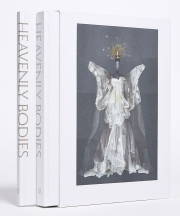Text by Cardinal Ravasi for the catalogue of the 2018 Spring Exhibition "Heavenly Bodies: Fashion and the Catholic Imagination" at the Costume Institute, New York.
On Priestly Garments
When I put on my cardinal’s robes or the sacred vestments for liturgical celebrations with Pope Francis, my thoughts often turn spontaneously to two divergent sets of images. One is the sculptor Giacomo Manzù’s powerful Cardinali, a series of more than fifty figures he created from the late 1930s through the late 1950s. Manzù’s stately cardinals, whether seated or standing, large or small, are truly imposing. Cast in bronze or carved of stone, their pyramidal forms culminate in the peak of a mitre. The figures, each cloaked by a simple yet majestic cape, are engaged in mystical meditation, immersed in contemplation of a timeless horizon. In stark contrast is the satirical and grotesque runway show of clerical fashions depicted by director Federico Fellini in an exhilarating sequence of his film Roma, from 1972. By that time Pope Paul VI had already vastly simplified the sumptuous cardinalate garb, for example cutting off the long tails of the cardinal’s cape, but Fellini’s caricature of clerical ostentation serves as an effective counterpoint to the grandeur of Manzù’s cardinal figures. From the solemn to the superficial, these images capture the full spectrum of the possibilities of sacred dress.
Liturgical vestments, like other objects dedicated to worship, are a veritable mirror of the historical phases of the Catholic Church. Indeed, clothing and material goods in general reflect their time and place; as Honoré de Balzac wrote in his Treatise on Elegant Living (1830), “Clothes are the expression of society.” They are effectively its self-portrait. Garments do not merely protect us from the cold and heat or from nakedness, although these perfectly legitimate functions are recognized in the Bible, when God at the dawn of humanity “made for Adam and for his wife garments of skins, and clothed them” (Genesis 3:21). But, as is clearly demonstrated in the creative world of fashion and is suggested by the linguistic connections among the Latin vestis (clothing), “vestment,” and “investiture”—a word indicating an appointment to an official position—clothing, through its symbolic dimension, also belongs to and expresses its culture.
The forty or so articles of clothing and sacred ornaments from the Vatican presented in the “Heavenly Bodies” exhibition and this accompanying catalogue are rightly classified under the category of “Catholic imagination,” as the subtitle recites. The wide range of objects shown includes a vast array of sacred paraments such as copes, chasubles, dalmatics, stoles, albs, episcopal mitres, papal tiaras, zucchettos, fascias, pectoral crosses, rings, and crosiers, as well as chalices and monstrances used in Eucharistic celebrations. The selection is indubitably sumptuous, a quality that was exalted during the Baroque period but has characterized liturgical ornamentation of the following centuries. Such opulence was intended to proclaim the divine transcendence, the sacred detachment of worship from daily ordinariness, the splendor of mystery.
That was not always the case. In the beginning, the ecclesial community met kat’ oikon, “at the home” of the various Christian families, as Saint Paul often recalls (for example, in Romans 16:5). In these modest settings, the table where lunch was served became the Eucharistic table. Until the fifth century, the ministers apparently wore ordinary clothes, albeit festive ones—not daily attire or military uniforms—and used simple glass chalices. Ecclesiastical clothing modeled on the vestments and decorations of the imperial order emerged later. Then began the long, complex, and rich development of sacred “fashion,” which reflected the tastes of the era and conferred upon every garment, even the most minor, a symbolic value. The latter conforms to the Pauline example (Ephesians 6:11–17), where the apostle deploys terms of military gear as spiritual metaphors: the armor of God, the belt of truth, the breastplate of righteousness, shoes in readiness to spread peace, the shield of faith, arrows of evil, the helmet of salvation, and the sword of the Spirit, which is the word of God.
Well before Paul, the Old Testament gave ample space to the subjects of priestly garments and the decoration of the holy tent of the covenant between God and Israel, the mobile sanctuary used during the march through the Sinai Desert and a prefiguration of the Temple of Zion in Jerusalem (Exodus 30–31, 35–40). These passages provide detailed prescriptions for making sacred vestments and objects, a project entrusted to an artist named Bezalel. To carry out his work, he was filled “with the Spirit of God, with ability, with intelligence, with knowledge, and with all craftsmanship, to devise artistic designs, to work in gold and silver and bronze, in cutting stones for setting, and in carving wood, for work in every skilled craft . . . [and] every sort of work done . . . by an embroiderer in blue and purple and scarlet stuff and fine twined linen” (Exodus 35:31–35). Bezalel’s inspiration was thus not only artistic but also divine, just like that given to the prophets.
With respect to rituals and the Christian liturgical apparatus, it is worth recalling Jesus’ admonition against purely external shows of observance; he criticized worshipers who for appearances’ sake “make their phylacteries broad and the fringes long,” referring to the tefillin and the tallit of Jewish practice (Matthew 23:5). Indeed, there remains in sacred ritual the risk that the English writer William Hazlitt highlighted in his essay “On the Clerical Character” (1818): “Those who make their dress a principal part of themselves, will, in general, become of no more value than their dress.” However, beauty and art have been the inseparable sisters of faith and Christian liturgy for centuries, especially in Catholicism and orthodoxy. And—as Henri Matisse’s marvelous mid-twentieth-century chasubles for the chapel of Vence, now conserved in the Vatican Museums, demonstrate—the bond between beauty and faith continues to revive and renew itself through a dialogue with contemporary art.
https://www.metmuseum.org/exhibitions/listings/2018/heavenly-bodies

